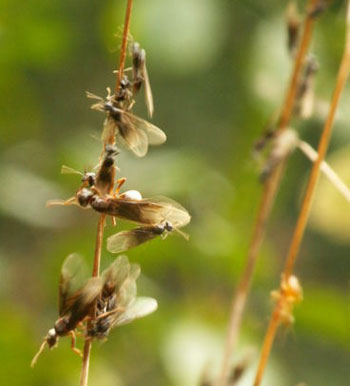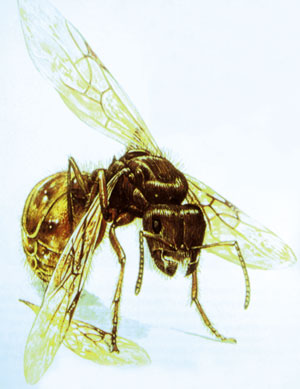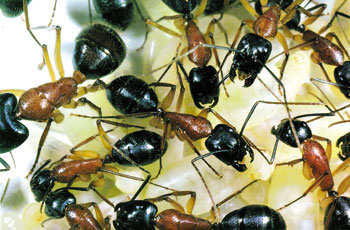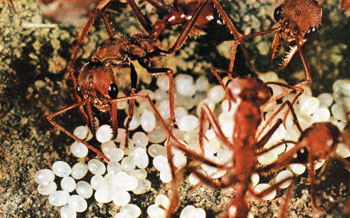A large portion of an ant colony is made up of female ants. Male ants have a rather shorter life span. Their only task is to mate when they mature with a young queen. Male ants die a short while after they mate. All worker ants are female. In short, all ant communities are, in fact, a world of mothers and daughters.
Ants are a harmonious society regardless of their number. In ant colonies, it is possible to see every stage in the life of a society. The purpose in life for ants, who are bound to their colonies with great sacrifice is not individual. They are, all together, like a single body and their purpose is to keep that body alive. They do not think twice before electing death, if it is for the survival of the colony. The best example of this is what happens to the male ants after the nuptial flight.
 |
The mating of ants looks almost like a ceremony. Most ants mate in the air. The males come earlier and wait for the young queen. When a female lands on the ground (the female also has wings before mating), 5-6 male ants start racing around the queen. When the female has obtained enough sperms, it sends out a certain vibration. The male understands this signal as meaning that the female is ready to detach. A short while after mating, the male ant dies.78
This type of sacrifice is in fact very hard to explain. The male ant taking the nuptial flight which will end in its death for the survival of its race is a type of behaviour that cannot be explained by the theory of evolution because, according to the fundamental logic of evolution, each living being only worries about the continuation of its own life. Yet, male ants have been fertilizing female ants for millions of years, knowing that at the end, death is inevitable.
The only truth that can explain this sacrifice is that the male ant acts under the inspiration of its Creator. Otherwise, it is impossible that a creature, which is alleged to go through the natural selection process, should preserve such sacrificial behaviour for millions of years. Judging by the basic principles of the theory of evolution, male ants would have to escape from this "death flight" one way or another, and this would mean the end of the ant species. Yet, currently, thousands of ant species still keep on living on earth with their colonies numbering hundreds of thousands. Not a single male ant has ever run away from this flight which means "the end" for it.
 |
| Above are ants during nuptial flight. On the left are seen female ants before the nuptial flight. |
After mating, the female ant looks for a suitable nest, and when she finds one, she enters it and promptly tears off her wings. Later on, she bars the entrance and stays without food and alone for several weeks. Then she lays her eggs. (During this time, she feeds on her wings). She feeds the larvae coming out first with her own saliva. This long-lasting and tough effort is another example of sacrifice, but in the remaining portion of her life, the queen will be fed by her colony.
Due to limited food, the first swarm is small. These are the first workers of the colony and take care of the following swarms continuing to make sacrifices in the same way. The new generation of ants that grows up under their exceptional care become larger, because they have better nutrition.
 |
| After the nuptial flight, the queen looks for a suitable place to found her colony. When she finds a place like she wants, she first tears off her wings and starts forming her own colony by reproducing. |
As we mentioned before, the lives of male ants are not very long. They die anything from a few hours to a couple of days after the nuptial flight. Yet, it is very interesting that each male who has taken the nuptial flight, risking death, has left sperms for its offspring to be born years after it dies. Well, how are these sperms preserved alive and how are they able to produce new ants by fertilizing the eggs? Can the ants have developed a superior technology and formed a sperm bank?
Yes, each queen ant has a sperm bank in her body. After receiving the ejaculate from the male, the queen stores it in an oval bag located near the tip of her abdomen. In this organ, called the spermatheca, the individual sperm are physiologically inactivated, and they can remain in suspended animation for years. When at last the queen lets them back out into her reproductive tract, either one at a time or in small groups, they become agile again and ready to fertilize the egg passing down the tract from the ovaries.79
This means that the sperm bank which has come into use over the last 25 years through high technology, has been used by the ants since time immemorial.
This mechanism of which, until 50 years ago, human beings had not the slightest inkling, has been used by ants for millions of years. Since the ants cannot go through stages man has gone through by setting up laboratories and having this mechanism placed in their bodies, they must have had this mechanism since the very beginning. If allegations are made to the contrary, many questions similar to the ones below shall have to be answered.
1. When the ants came into existence for the first time, did not the males die after the nuptial flight? If they did not, then why are they dying now? Did they think that it was more appropriate to be destroyed after the death flight as part of the survival of the fittest process?
2. Since male ants die right after the nuptial flight, would not the ant species have been extinct long time ago had it not been for the formation of the sperm storage required for the survival of their species?
3. If the sperm bank has existed since they first came into existence, then who has equipped their bodies with this mechanism?
These are just a few of the questions that must be answered by those who do not accept the supreme creation by the Creator. Thousands more questions may be formulated just on the subject of the survival of the ant species and each one of these questions points to creation by design and renders evolutionist claims impossible.
 |
| The sole task of one group of worker ants in ant colonies is to look after the eggs and larvae. These workers are generous with their time. They spend every moment of their lives guaranteeing the survival of their species. |
The eggs that the queen ant lays and immature young ants both live in the child care chambers of the nest. If the temperature and humidity become such that they may harm the young, then worker ants carry the eggs and the young ants to a more suitable environment. They keep the eggs close to the surface in the daytime to benefit from the heat and take them to deeper chambers at night or on rainy days.
This means that the workers try to protect the eggs and young ants with great care and try to keep them comfortable. Some of them take the larvae around the nest on a hot day to cool them down and some of them cover the walls of the nest with discarded cocoons to prevent humidity and some of them seek food. Every single one of these actions shows that ants act out of very kind consideration. One ant will take the larvae around the nest to cool them, while another ant will insulate the wall of the nest by cocoons to adjust the temperature – a very modern insulation technique. Yet, it must not be forgotten that this being which we regard as having made a kind gesture, does not have any thinking capacity. Regardless of how advanced its technology may become, science will never be able to find the cause of this sacrifice displayed by a tiny bug. Furthermore, this sacrifice is in total contradiction of the most fundamental principles of the theory of evolution.
All these examples show that these living beings also act under Allah's inspiration and that they obey Him. This secret is explained in the Qur'an as follows:
Everything in the heavens and every creature on the earth prostrates to Allah, as do the angels. They are not puffed up with pride. They fear their Lord above them and do everything they are ordered to do. (Surat an-Nahl, 49-50)
 |
| For worker ants, the maintenance of the eggs are very important. Above, workerants that look after the queenÕs eggs are seen. |
All the activities of ant colonies centre on the queen and her eggs. The ants hold their queens, who ensure the reproduction of their colonies, in high regard. All their needs are met by worker ants. The most important thing a worker ant does is to serve the queen and ensure her survival and her babies.
Ant eggs are the most valuable treasure of the colony. The first thing the ants do when they sense any danger to their larvae is to take the babies to a secure place. Yet, since baby ants die within a couple of hours of coming into contact with the dry air outside, worker ants try to keep the air humid in the sections where the larvae are. There are various techniques they have developed for this. First of all, they build their nests in such a way as to keep the moisture of the air and soil within tolerable limits. In addition, ants who assume the task of being caretakers of the babies, regularly shift brood up and down through the dense system of chambers. They try to find the most suitable environment for them. Furthermore, the needs of brood vary according to age. For instance, while eggs and larvae need a humid environment, the pupae have to be in a strictly dry medium. Workers keep on working for 24 hours without rest to complete these tasks.80
The worker ants in the colony have dedicated themselves to raising the eggs of their constantly laying queen instead of laying eggs themselves. They take many risks on this score, because the humid medium required for eggs and larvae is ideal for the growth of bacteria and fungi that are potential health hazards for the ants.
Then, how are the workers protected in such an unhealthy environment? Allah, Who has created ants with their magnificent systems, has given them another defence technique. The metapleural glands in the thorax of adult ants continuously secrete substances that kill bacteria and fungi. Therefore, ant colonies are rarely struck by bacterial or fungal infections.81
Charles Darwin, who is the originator of the theory of evolution, has suggested that the basic motivation of the process of evolution was that of staying alive. In Darwin's view, when individuals of a species acquire traits that increase their chances for survival, those individuals have an advantage; due to this advantage, they survive and produce relatively more living offspring, thus eventually spreading the trait throughout their species. Evolution, therefore, would be expected to favor self-preservation, not self-sacrifice.82
Yet, Darwin's theory of natural selection was given a shattering blow by the discovery of so many incredible examples of self-sacrifice shown by ants. It was very difficult for proponents of the theory of evolution to produce an explanation of such characteristics, some of which were found while Darwin was still alive. In fact, Darwin himself stated in his book, called The Origin of Species:
“Many instincts are so wonderful that their development will probably appear to the reader a difficulty sufficient to overthrow my whole theory. I may here premise that I have nothing to do with the origin of the mental powers, any more than I have with that of life itself. ”83
After such an open confession, the hypothesis he set forth in order to save his theory is beset by even greater complications. According to the explanation Darwin brought to this conflicting situation, natural selection was realized not at the level of individual, but at the group level within certain groups.
However, this could not go any further than a claim impossible to prove, because it was just an estimate which was set forth for the sake of saving the theory, which did not depend on any solid findings or observations. Evolutionists who came after Darwin could never explain the examples of sacrifice in animals.
It is impossible to explain the examples of sacrifice and generosity experienced among ants, termites, bees and other social insects by any technique offered by the theory of evolution. There is only a single explanation for a living being to put its own security and comfort at risk in order to work on providing security and comfort for members of the group it lives in: the social order of the group has been determined by a conscious designer and this designer has assigned different tasks for each member of the group. The members of the group abide by this task distribution and if necessary, sacrifice themselves. What is important is the survival of the order of the group, and the sacrifice needed for it may be achieved, not by the will of insects lacking any consciousness and judgement, but by the will that directs them.
78 National Geographic, June 1984, p. 790-791
79 Bert Hölldobler-Edward O.Wilson, Journey to The Ants, Harvard University Press, Cambridge, 1994, p. 30
80 Bert Hölldobler-Edward O.Wilson, The Ants, Harvard University Press, 1990, p. 374
81 Bert Hölldobler-Edward O.Wilson, Journey to The Ants, Harvard University Press, Cambridge, 1994, p. 195
82 The Insects, by Peter Farb and the Editors of Time-Life Books, p. 170
83 The Origin of Species, Charles Darwin, London: Senate Press, 1995, p. 273